PLANETS
Pluto: The Dwarf Planet
- Published On
October 8th, 2024
- Author
Ayaan Atif
Introduction
Throughout history, humanity’s quest for knowledge has often been a tumultuous one, fraught with uncertainties and subject to constantly evolving interpretations. Nowhere has that been clearer than in our perception of our cosmic backyard, the solar system. Practically every child is taught the infamous lineup at a young age. From the rusty sands of Mars to the icy depths of Neptune, they often serve as our gateway into the boundless expanse of space, or our first contact with the great beyond. Most of us grow up learning there are eight distinct planets in the solar system, orbiting our Sun in a familiar, ordered path. But what if I told you that wasn't always the case? What if I told you that, once upon a time, there was one more? Before you dismiss this as a mix-up, let me take you back to a moment that changed our cosmic perspective forever: the reclassification of Pluto. Once hailed as the enigmatic ninth planet, Pluto was downgraded to a dwarf planet, sending shockwaves through the world of astronomy. What we thought we knew about our solar system was suddenly upended, leaving us to redefine the very nature of what makes a planet.
With a density of 1.86 grams per cubic centimeter—about 40% of Earth's—and a diameter of 1,473 miles (2,370 kilometers), as measured by the New Horizons mission, Pluto is even smaller than several moons in our solar system, including Saturn’s largest moon, Titan. This reclassification of Pluto as a dwarf planet was fueled by advancements in our understanding of planetary characteristics, sparking ongoing debates among scientists and the general public alike. But how did we arrive at this point? When was Pluto discovered, and by whom? In this article, we’ll explore these questions and uncover the fascinating journey that led to Pluto's discovery and its changing status in the solar system.
The Path To Discovery
In 1781, Sir William Herschel peered through his telescope and observed Uranus, initiating a series of astronomical calculations that would lead to groundbreaking discoveries. Initially, Uranus' gravitational effect was explained through shaky calculations, but later Urbain Le Verrier, French astronomer and mathematician, used mathematics to correctly predict the existence of another planet—Neptune. However, Neptune turned out to be too small to completely account for the peculiarities in Uranus' orbit, leading to an 85-year-long search for another planet.
During this time, historical events like Gandhi's civil disobedience movement and the Great Depression were unfolding. However, amidst all the hustle and bustle, Clyde Tombaugh, a young 20-year-old with a passion for space, made planet sketches in 1928 using a telescope he assembled himself. He built the 23-centimeter reflector telescope from the crankshaft of a 1910 Buick and parts from a cream separator, which eventually helped him land a job at the Lowell Observatory in 1929, an institution founded in 1894 by Percival Lowell. Lowell, if you didn’t know, was an influential American astronomer and one of the first to hypothesize the existence of a ninth planet, which he called "Planet X" based on his assessment of irregularities in the orbits of Neptune and Uranus. Going back to Tombaugh, he used the telescope at the Lowell Observatory, which was equipped with a specialized camera designed to take two separate photographs of the same region of the sky on different nights. To detect subtle movements in the vast sea of stars, he also used a device called a blink comparator, which rapidly alternated between the two images, allowing him to visually compare them and find any object closer to Earth—such as a planet—that would shift slightly in position between the two photos.
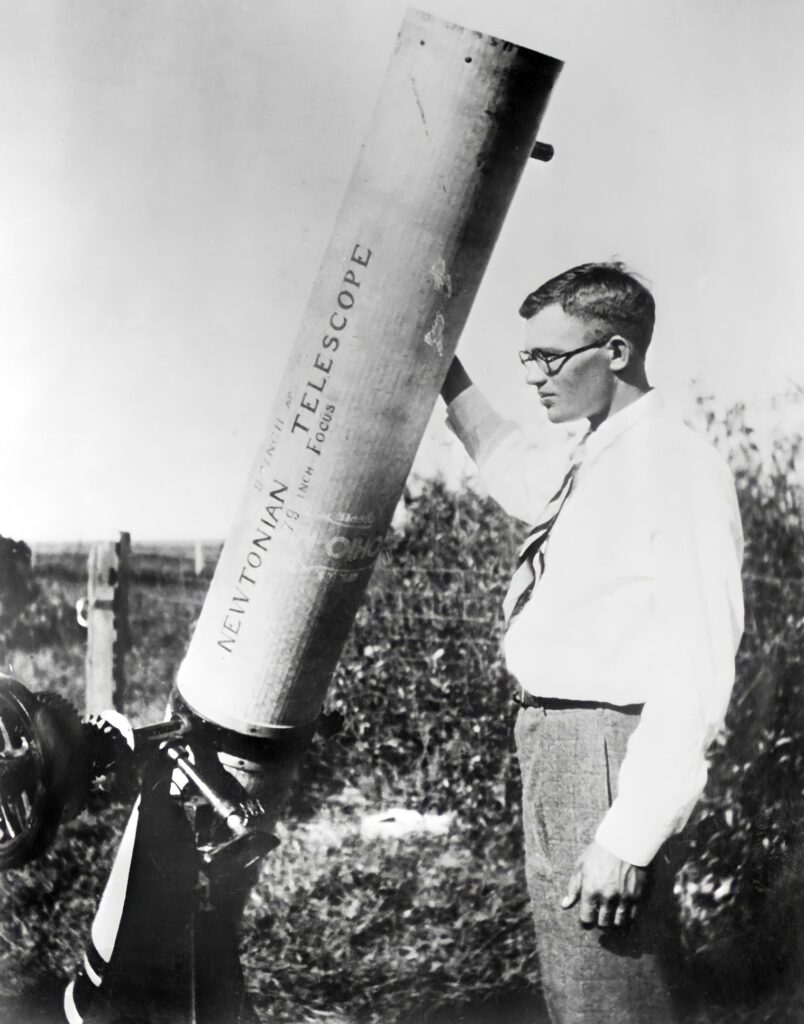
The telescope featured a 23-centimeter reflector design, which allowed for enhanced light-gathering capability, enabling Tombaugh to observe celestial objects with greater clarity. It was with this homemade telescope that Tombaugh conducted meticulous observations of the night sky, leading to his discovery of Pluto. (Photo Credit: Getty Images)
Tombaugh spent a week per pair with the photos covering an estimate of 150,000 stars, and carefully scanned for any small moving object that could potentially be "Planet X." After months of tireless work, his dedication paid off on the 18th of February 1930 when he meticulously compared photographic plates from January 23rd and 29th, 1930, leading to the discovery of Pluto in the constellation Gemini. Appearing as a dim “star” of the 15th magnitude, it was seen changing its position against the fixed background stars.
The discovery of Pluto, announced by the Lowell Observatory on March 13, sparked global interest, leading to thousands of postcards being sent from people all over the world with suggestions for its name. Eventually, the name proposed by an 11-year-old girl from England, Venetia Burney, was passed on to her grandfather, Falconer Madan, a former librarian at the University of Oxford’s Bodleian Library. He then forwarded it to Professor Herbert Hall Turner, who cabled it to his colleagues in the United States, leading to its selection and five pounds for Venetia as a reward. She suggested naming the new planet after the Greek god of the underworld, Pluto—a fitting name given the planet's dark, distant location from the Sun. Pluto officially became Pluto on March 24, 1930. As each planet had its own symbol, the symbol invented for Pluto, ♇, stands both for the first two letters of Pluto and coincidently, the initials of Percival Lowell.

As indicated by the arrows in both images, you can observe the faint dot moving through space over a six-day period, which ultimately led to the discovery of Pluto. This subtle movement captures the dynamic nature of celestial objects and highlights the meticulous tracking efforts of astronomers as they pieced together the clues that would reveal the presence of Pluto in our solar system. (Photo Credit: The Lowell Observatory)
Pluto As A Planet
Pluto exhibits a unique and complex environment that sets it apart from the other planets in our solar system. Its surface is characterized by a striking variety of geological features, including expansive plains, towering mountains, and distinct regions with differing compositions. The most prominent area is Tombaugh Regio, a heart-shaped plain primarily composed of nitrogen ice. Within this region lies Sputnik Planitia, a smooth, crater-free expanse that indicates relatively recent geological activity. The smoothness of Sputnik Planitia suggests that it is a young feature, possibly shaped by cryovolcanism, where volatile substances erupt from beneath the surface in a manner akin to volcanic activity. This geological youth hints at the possibility that Pluto may still be undergoing internal processes, making it a dynamic world despite its great distance from the Sun.
Surrounding Tombaugh Regio are rugged mountain ranges composed of water ice, likely floating atop the surrounding nitrogen ice, revealing the planet's complex layering and density. The mountains of Pluto reach heights of up to 3,500 meters (11,500 feet), showcasing significant topographical diversity. Darker regions, such as Cthulhu Regio, contrast sharply with the bright expanses and reveal a landscape rich in organic compounds known as tholins, which give the terrain its deep red coloration. These varied geological features, combined with Pluto's average reflectivity—an albedo of 0.72—demonstrate a world rich in complexity and contrast. The spectral observations made during the New Horizons mission revealed that Pluto’s surface is composed of a mix of nitrogen, methane, and carbon monoxide ices, highlighting its dynamic composition and potential for atmospheric interactions.
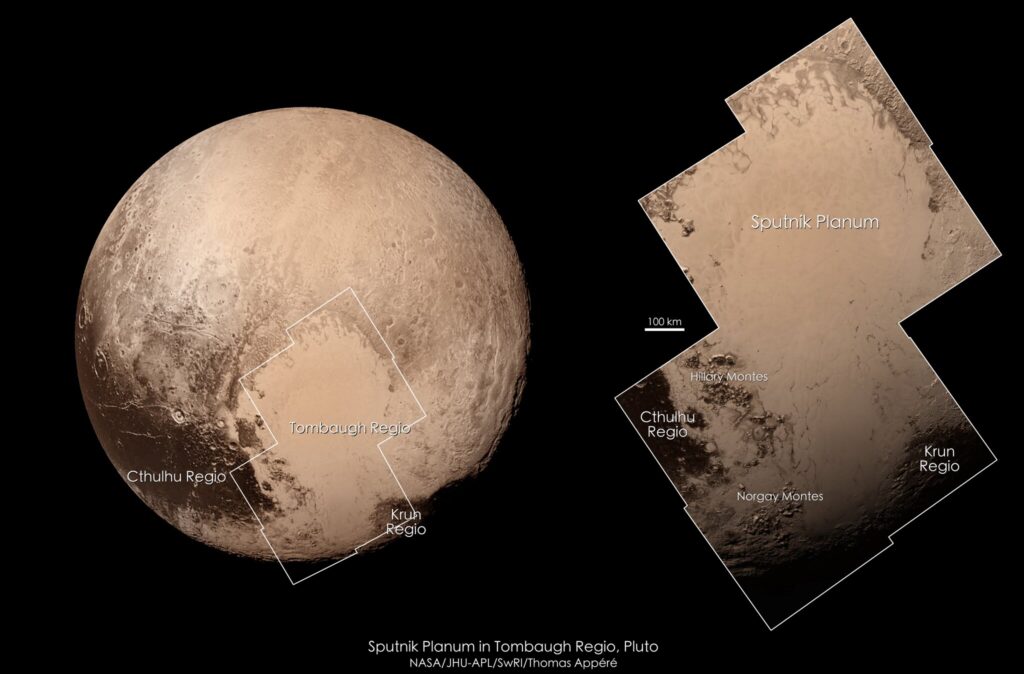
Location of the LORRI mosaic on Pluto, shown on a full-globe image captured by NASA's New Horizons spacecraft on 13 July 2015. (Photo Credit: NASA)
Pluto's orbit is particularly noteworthy, as it deviates significantly from the typical patterns observed among the major planets. Its orbit is highly eccentric, ranging from 29.7 AU at perihelion (its closest point to the Sun) to 49.5 AU at aphelion (its farthest point). This eccentricity means that for a small portion of its orbit, Pluto is closer to the Sun than Neptune. However, the two bodies will never collide due to a gravitational resonance that stabilizes their paths. Specifically, Pluto completes two orbits for every three orbits of Neptune, ensuring they remain separated by at least 17 AU. This intricate orbital dance reflects the gravitational interactions that govern the dynamics of the outer solar system.
Additionally, Pluto’s axis of rotation is tilted at a remarkable 120° from the perpendicular to its orbital plane, causing it to rotate nearly on its side and move in a retrograde direction. This unusual tilt results in extreme seasonal variations, leading to dramatic shifts in temperature and atmospheric pressure as Pluto orbits the Sun over its long 248-year cycle. The temperature near Pluto's surface can drop to around 40 K (−233 °C, or −387 °F) during its aphelion, while it may reach slightly warmer conditions during perihelion. As a result, the atmosphere (that extends as far as 1,000 miles (1,600 km) above the surface of the dwarf planet) is primarily composed of nitrogen, with traces of methane, carbon monoxide, and other gasses, creating a thin, hazy layer that varies in density depending on Pluto's distance from the Sun.
Charon
In 1977, astronomers James Christy and Robert S. Harrington discovered that Pluto had a moon. This discovery came after they noticed a bulge in one of the photographs taken by a 61-inch telescope in the U.S. Naval Observatory's Flagstaff Station in Arizona, which was initially dismissed as a photographic error. The moon was later named Charon after the mythological ferryman of souls to the underworld in Greek mythology and also partly due to its similarity to the nickname of Christy’s wife, Charlene, whose nickname was “Char.” The discovery of Charon added complexity to Pluto’s status, as the two bodies were believed to orbit each other, leading scientists to refer to Pluto and Charon as a double dwarf planet, double planet, or binary system.
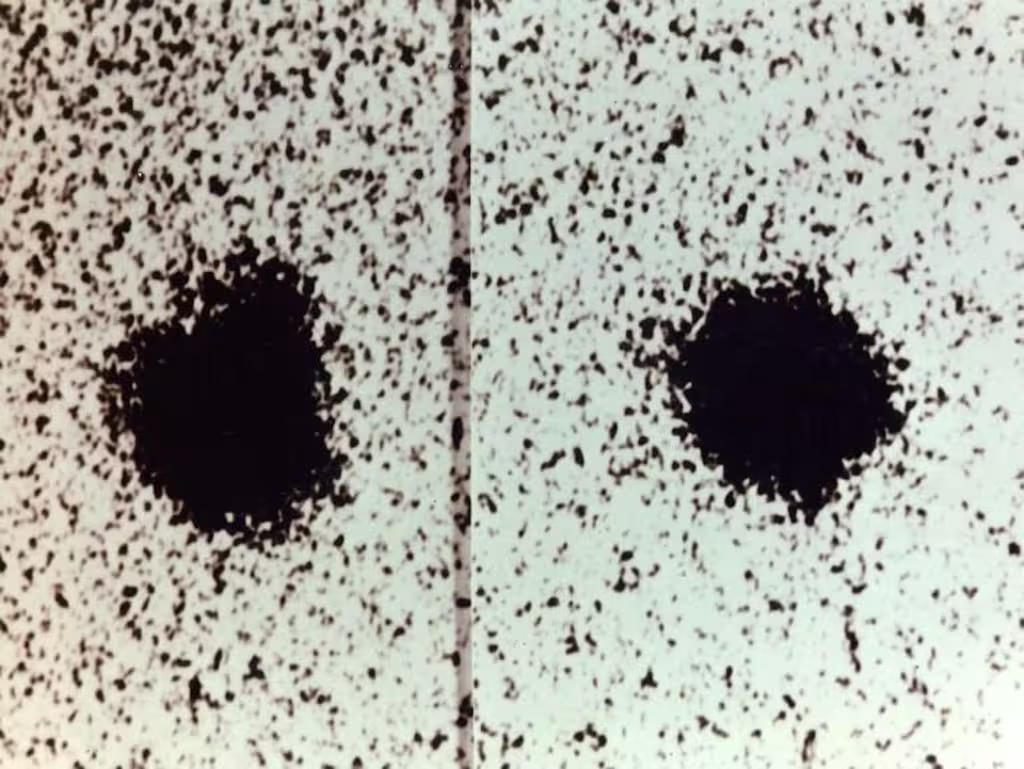
A side-by-side comparison of two images of Pluto taken by a 61-inch telescope in 1978. The right image shows Pluto as a small, almost spherical dot, with no noticeable distortions in its shape. The left image, however, captures a bulge on the top right of Pluto, an unexpected distortion that would later lead to the discovery of its moon, Charon. (Image credits: U.S. Naval Observatory)
Since the discovery, however, the origins of Pluto and its moon Charon have been the subject of extensive study and debate among astronomers, leading to several theories about their formation. One prevailing hypothesis suggests that both bodies formed as independent entities within the solar nebula, the gaseous cloud from which the solar system originated. This theory posits that a collision between Pluto and a proto-Charon created a debris ring around Pluto, from which Charon eventually coalesced. This formation scenario is analogous to the widely accepted model for the Moon's origin, which resulted from a giant impact between Earth and a Mars-sized body. Another theory proposes that Pluto and Charon might have formed as part of a larger population of icy planetesimals in the outer solar system, with similar dimensions and compositions. This is supported by the observation of other Kuiper Belt Objects (KBOs), which share orbital characteristics with Pluto, indicating that many bodies in this region likely originated from the same material. The presence of Pluto's smaller moons also suggests they could be remnants of the initial collision that formed Charon, further complicating the narrative of their origins.
Charon, about half the size of Pluto, is the largest moon relative to its planet, with a mass of more than one-tenth of Pluto's mass. With an approximate diameter of 1,212 km, it follows a circular orbit with a radius of 19,640 km, taking about 6.38 Earth days to complete one revolution. Spectral analysis of light reflected from Charon reveals that its surface is primarily covered by water ice, in sharp contrast to the frozen methane prevalent on Pluto. The two are mutually tidally locked, meaning Charon always presents the same face to Pluto, and Pluto always presents the same face to Charon.
Regarding the surface, the northern hemisphere is considered rugged and cratered, while the southern side is known to be smoother, with the Vulcan Planum being a vast, smooth plain. As previously mentioned, the surface primarily contains water ice, especially at the poles, which are covered with reddish material produced by gas ejected from Pluto. This occurs because Pluto's size does not allow it to retain its atmosphere (consisting of carbon monoxide, methane, and nitrogen) for its entire lifetime, according to NASA’s studies. Additionally, the surface temperature is estimated to range between -396°F and -360°F due to its great distance from the Sun, the primary source of energy and heat in our solar system.
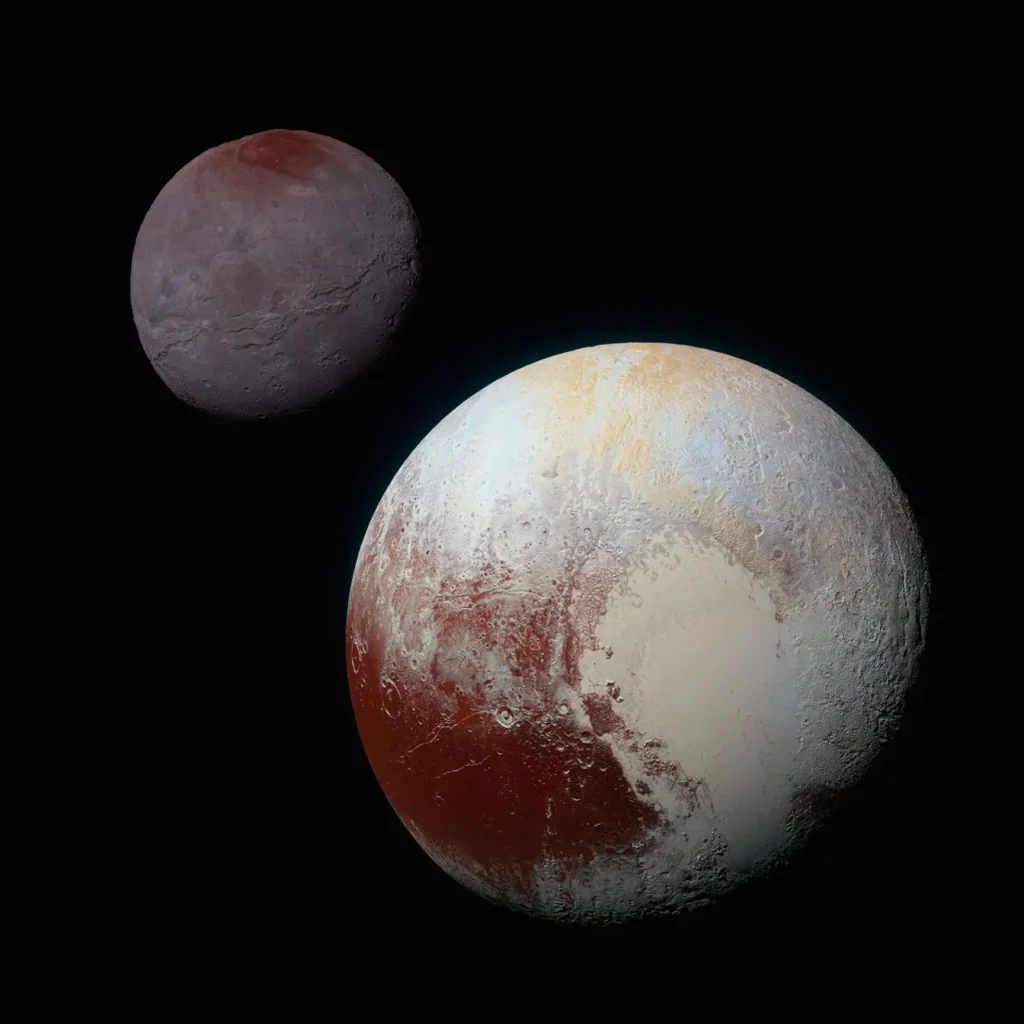
This colored image was taken through New Horizons during its flyby in July of 2015. It shows Charon’s rugged terrain (top left) in detail, with shades of gray and reddish-brown marking its icy surface and displaying its size as compared to its companion, Pluto (low right). (Image credits: NASA, Johns Hopkins University Applied Physics Laboratory)
Although we don’t know much about when and how Charon formed, we can infer from its heavily cratered surface that it is older than Pluto. Moreover, its size and surface features lead scientists to believe that it is one of the largest objects in the Kuiper Belt. Charon was the only known moon of Pluto until 2005 when the Hubble Space Telescope discovered two more tiny objects orbiting Pluto, later named Nix and Hydra.
Nix & Hydra
According to NASA, both moons are 5,000 times fainter than Pluto and are located about two to three times farther from Pluto than Charon. In mythology, Nyx is the goddess of the night, and one of her many offspring was Charon, the ferryman who transported the souls of the dead across the river Styx to the underworld. Since asteroid 3908 was already named Nyx, the International Astronomical Union (IAU) renamed Pluto’s moon to its Egyptian equivalent, Nix.
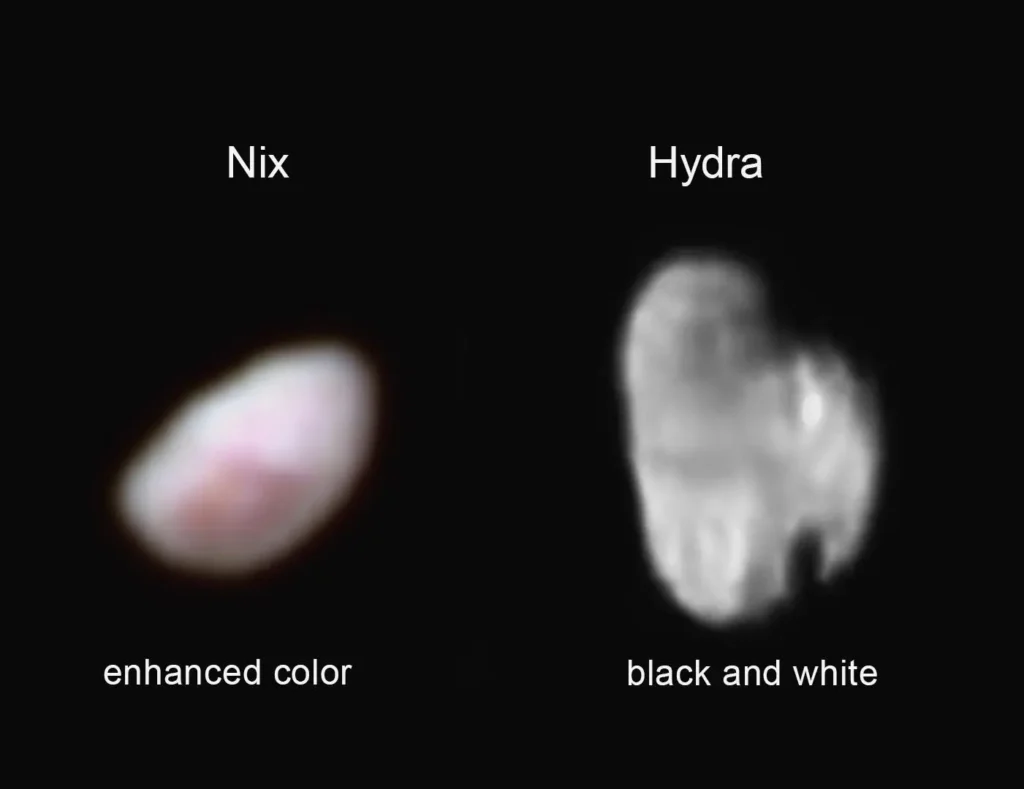
The image captured by the New Horizons Ralph instrument shows Pluto’s moons Nix and Hydra in hazy detail. Nix appears as a small, irregularly shaped object, with faint hints of a reddish patch that could indicate an impact crater. Hydra, slightly brighter, also shows a rough and uneven surface but remains somewhat blurred due to the distance and lighting conditions. (Photo Credit: NASA)
The mythological Hydra was a nine-headed serpent with poisonous blood, and its lair was said to be at the entrance to Hades, where Pluto and his wife Persephone entered the underworld. In astronomical terms, Hydra is Pluto's second-largest and outermost moon, with a diameter of 51 kilometers, as determined by the Long Range Reconnaissance Imager aboard the New Horizons spacecraft. Like other moons such as Charon, Hydra has an icy, reflective surface (Reflectivity of 85 percent). The name Hydra was officially approved by the IAU on 21 June 2006, alongside the naming of Nix, as announced in IAU Circular 8723. Little is known about Hydra’s origin, but scientists believe it may have formed from debris ejected during a massive collision between Pluto and another Kuiper Belt object. Hydra orbits the Pluto-Charon barycenter at a distance of 64,738 km (40,226 mi) and takes approximately 38.2 days to complete one orbit, with a time discrepancy of just 0.3% compared to Charon.
The first image of Hydra was downlinked from the New Horizons spacecraft on 15 July 2015, following its flyby. This image, taken from a distance of 640,000 km (400,000 mi), revealed brightness variations and a dark circular feature about 10 km (6.2 mi) across. The highest resolution image of Hydra which you can see above was captured from a distance of 231,000 km (144,000 mi), with a resolution of 1.2 km (0.75 mi) per pixel. Based on it, Hydra was estimated to have an approximate size of 55 km × 40 km (34 mi × 25 mi).
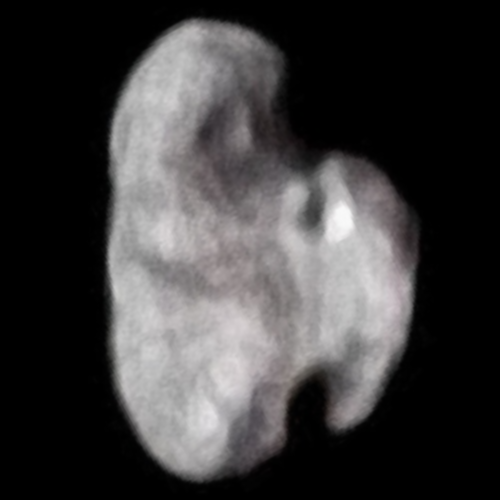
A near true-color image of Hydra, taken by New Horizons on 14 July 2015, reveals the moon’s irregular structure and bright, reflective surface. Hydra’s high reflectivity is likely due to its water-ice content, making it stand out in contrast against the darkness of space. (Photo Credit: NASA)
The third moon discussed in this study is Nix, which was discovered on May 15, 2005, alongside Hydra using the Hubble Space Telescope. It was named after Nyx, the Greek goddess of the night, but its spelling was adjusted to "Nix" to avoid confusion with an asteroid. Orbiting between the moons Styx and Kerberos, Nix is the third moon of Pluto in terms of distance. With a length of an estimated 26 miles (42 km) and a width of 20 miles (32 km) wide as per measurements by New Horizons, it has captured interest due to its unusual rotation and surface features, including a reddish impact crater observed by the New Horizons spacecraft during its 2015 flyby.
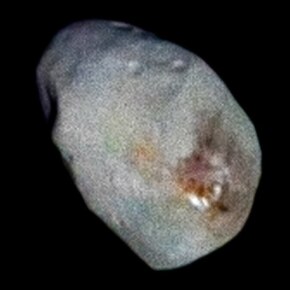
This enhanced image of Pluto's moon Nix was taken by NASA's New Horizons spacecraft. It's one of the best images of Nix captured by the mission, showcasing the moon's irregular shape and unique surface features. (Photo Credit: NASA Science)
The third moon discussed in this study is Nix, which was discovered on May 15, 2005, alongside Hydra using the Hubble Space Telescope. It was named after Nyx, the Greek goddess of the night, but its spelling was adjusted to "Nix" to avoid confusion with an asteroid. Orbiting between the moons Styx and Kerberos, Nix is the third moon of Pluto in terms of distance. With a length of an estimated 26 miles (42 km) and a width of 20 miles (32 km) wide as per measurements by New Horizons, it has captured interest due to its unusual rotation and surface features, including a reddish impact crater observed by the New Horizons spacecraft during its 2015 flyby.
The discovery of Nix was a result of astronomers' efforts to locate additional moons around Pluto. Max Mutchler and Andrew Steffl were instrumental in identifying Nix, using long exposure images due to its faint brightness—about 5,000 times dimmer than Pluto. Their findings were confirmed through archival Hubble data from 2002, and Nix was initially designated as S/2005 P 2. The formal announcement of its discovery came on October 31, 2005, solidifying Nix’s place as one of Pluto’s known moons, along with its sibling Hydra.
Nix's chaotic rotation, influenced by the gravitational forces of Pluto and Charon, is a distinctive feature. Unlike Pluto’s largest moon, Charon, Nix is not tidally locked, causing it to tumble unpredictably. Its orbital path lies roughly 48,694 km from Pluto, and it resonates with both Styx and Hydra. This intricate relationship, along with its elongated shape and surface composition—largely composed of water ice—provides astronomers with valuable insights into the formation and evolution of Pluto's moon system.
Styx & Kerberos
The discovery of Pluto's last two and smallest moons, Styx and Kerberos, came up in 2011 when a team of six astronomers that were trying to find potential rings around Pluto first identified Kerberos in HST images. Following the precedent set by earlier discoveries of Pluto's moons Nix and Hydra, the team delved into archival Hubble data, meticulously reanalyzing images from 2006 and 2010 to uncover faint traces of Kerberos. This careful examination highlights the value of ongoing observation and analysis in expanding our understanding of the cosmos.
In 2012, the HST was employed once more, leading to the discovery of Styx. Now, coming to the interesting side of the story is on how they got their names. Initially referred to as "P4" and "P5," the discovery team made a bold choice by allowing the public to participate in naming these moonlets, a departure from the traditional designations issued by the International Astronomical Union (IAU). The public was invited to vote on 21 candidate names inspired by mythological realms, resulting in the official names: Kerberos for P4 and Styx for P5.
In Greek mythology, Styx represents the river that separates the living world from the underworld, while Kerberos is the three-headed dog guarding its entrance—a fitting tribute to their association with Pluto, the Roman god of the underworld. Although there was a strong push for the name Vulcan, associated with the Roman god of volcanoes and steeped in astronomical history, the IAU ultimately endorsed the names Kerberos and Styx, enriching the roster of known planetary satellites to 180.
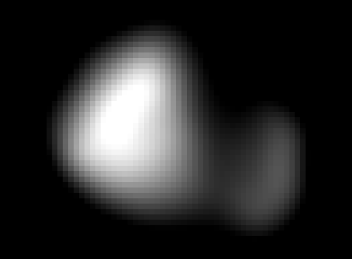
This image of Kerberos was generated by merging four individual photographs captured by the Long Range Reconnaissance Imager (LORRI) on July 14, approximately seven hours prior to New Horizons' closest approach to Pluto. (Photo Credit: NASA)
First, let's talk about the second smallest moon, surpassed only by Styx: Kerberos. This moon has a double-lobed shape, with the larger lobe measuring around 5 miles (8 km) across and the smaller lobe approximately 3 miles (5 km) across. Kerberos exhibits a high albedo, likely due to water ice on its surface, which contrasts with earlier beliefs that it had a darker appearance. Observations from the New Horizons mission revealed that Kerberos is significantly brighter than previously thought, showcasing its reflective surface and enhancing our understanding of its composition. Despite being only about 10% as bright as Nix, Kerberos's discovery was aided by the use of longer exposure times during imaging, which allowed astronomers to capture faint details that shorter exposures had missed. At the time of the New Horizons flyby on July 14, 2015, Kerberos was found to have a chaotic rotation period of roughly 5.33 days, with its rotational axis tilted about 96 degrees to its orbit, causing it to rotate sideways relative to its path around the Pluto-Charon barycenter. This chaotic rotation is a result of gravitational interactions with Pluto and its other moons, leading to a complex and dynamic orbital behavior that is characteristic of many small celestial bodies in the Kuiper Belt.

This composite image of Pluto's smallest moon, Styx, was captured by the Long Range Reconnaissance Imager (LORRI) on July 14, 2015, when the New Horizons spacecraft was approximately 391,000 miles (631,000 kilometers) away from the diminutive moon. (Photo Credit: NASA)
Now, let's talk about the smallest moon and the fifth and final one, Styx. With an estimated diameter of approximately 16 kilometers (9.9 miles), it is half as bright as Kerberos, the dimmest previously known moon in the system, and about one-hundred-thousandth as bright as Pluto itself. Styx orbits the Pluto-Charon barycenter at a distance of 42,656 kilometers, positioned between the orbits of Charon and Nix. The moon exhibits an elongated shape, measuring roughly 16 km × 9 km × 8 km (9.9 mi × 5.6 mi × 5.0 mi), and has an orbital period of 20.1 days.
The discovery of Styx came during survey work aimed at preparing for the New Horizons mission, which flew by the Pluto system on July 14, 2015. The revelation of Styx heightened concerns regarding the presence of additional small bodies in the region that could pose navigational hazards to the spacecraft. Styx is thought to have formed from debris resulting from a collision involving Pluto and another sizable Kuiper Belt object, leading to a complex moon system reminiscent of the early giant impact believed to have created Earth's Moon. Styx's chaotic rotation, unlike its nearly circular and coplanar orbit, is characteristic of small celestial bodies and reflects the dynamic nature of Pluto’s moon system. It is also in an 11:6 orbital resonance with Hydra and an 11:9 resonance with Nix, contributing to a unique sequence of orbital relationships among Pluto’s moons.
Missions
NASA's New Horizons mission to Pluto and its moons was a groundbreaking endeavor that greatly enhanced our understanding of the outer solar system. After its launch in 2006, New Horizons traveled over 3 billion miles, making its closest approach to Pluto on July 14, 2015. The mission was notable for being the first to visit Pluto, a dwarf planet that had remained largely unexplored due to its remote location. As New Horizons approached, it began to collect data on Pluto's atmosphere, surface composition, and geology, yielding a wealth of information that challenged existing theories about this distant world.
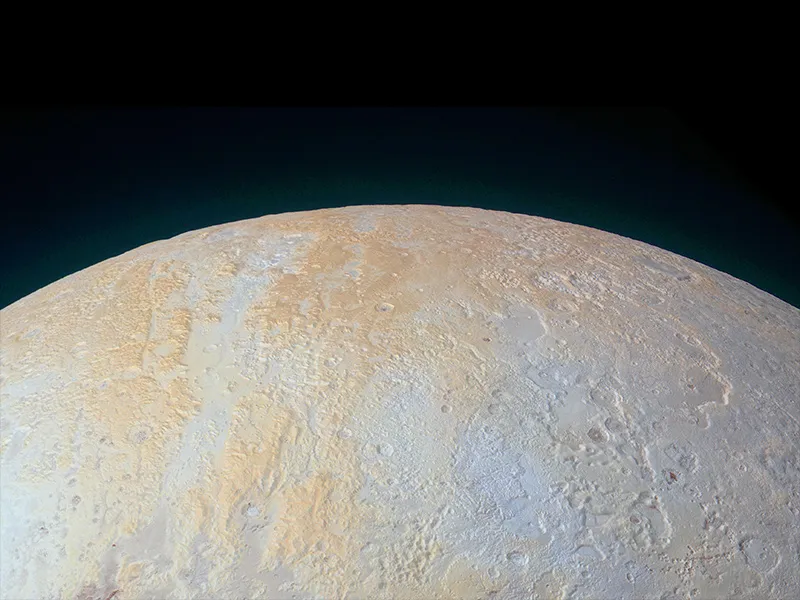
This stunning scene, captured by NASA's New Horizons spacecraft, beautifully illustrates the rich geological and compositional diversity of Pluto. The enhanced color image focuses on the enigmatic north polar region, revealing a breathtaking array of features that hint at the complex history and dynamic processes occurring on this distant world. (Image Credit: NASA)
As technology advanced, the Hubble Space Telescope was launched in 1990, allowing astronomers to capture unprecedented views of the cosmos, including Pluto. In 1996, Hubble managed to capture the best images of Pluto available at the time, although they were still limited. Despite these advances, Pluto remained largely unexplored, which sparked interest in an unmanned mission. Efforts to explore Pluto faced many challenges. NASA initially proposed the Mariner Mark II mission, which would explore Pluto and objects in the Kuiper Belt, but the project became too expensive and was ultimately scrapped. However, a group called Pluto Underground continued advocating for a mission, undeterred by the obstacles. In the end, New Horizons was launched, finally setting course for Pluto in 2006.
The New Horizons mission yielded significant discoveries, revealing a complex and varied surface on Pluto. The spacecraft's high-resolution images showed geological features such as mountains made of water ice, vast plains of nitrogen ice, and a heart-shaped feature known as Tombaugh Regio, in honor of Pluto’s discoverer, Clyde Tombaugh. Interestingly, Tombaugh’s ashes were aboard the New Horizons spacecraft, symbolically connecting him to the celestial body he discovered. The mission confirmed that Pluto is still geologically active, reshaping scientists’ understanding of icy bodies in the Kuiper Belt and beyond. New Horizons also provided insights into Pluto's moons, particularly Charon, which exhibited evidence of tectonic activity and a canyon system. Together, these findings expanded our knowledge of Pluto and its moons and reignited debates about Pluto's classification, opening new possibilities for future exploration in the far reaches of the solar system.
Removal Of Planet Status
The debates surrounding Pluto's planetary status intensified, culminating in a significant decision made by the International Astronomical Union (IAU) on August 24, 2006. At precisely 15:34 CEST, the IAU voted on two key resolutions that led to the reclassification of Pluto as a "dwarf planet." This shift meant that only the rocky worlds of the inner solar system and the giant planets of the outer system would be recognized as planets. The inner solar system encompasses the region smaller than the radius of Jupiter's orbit, which includes the asteroid belt and the terrestrial planets: Mercury, Venus, Earth, and Mars. The giant planets—Jupiter, Saturn, Uranus, and Neptune—remained in the planetary category, resulting in an official count of eight planets instead of nine.
According to the IAU, a "dwarf planet" is defined as a celestial body that orbits the Sun and possesses enough mass for its shape to be governed by gravitational forces, leading to an ellipsoidal shape, but has not cleared its neighboring region of other objects. To qualify as a full-sized planet, a celestial body must meet three criteria: it must orbit the Sun, have sufficient mass to achieve hydrostatic equilibrium (a nearly round shape), and have cleared the neighborhood around its orbit. While Pluto meets the first two criteria, it fails to satisfy the third, as it shares its orbital space with other Kuiper Belt Objects (KBOs), such as the plutinos, meaning it lacks gravitational dominance in its vicinity.

This image captures the pivotal moment during the General Assembly of the International Astronomical Union (IAU) in 2006, where delegates gathered to vote on the reclassification of Pluto. The voting process involved attendees using yellow cards to express their opinions on crucial resolutions concerning the definition of a planet and the status of dwarf planets. (Photo Credit: IAU)
The decision to redefine Pluto's status arose after the discovery of several KBOs comparable in size to Charon, with one—Eris—being slightly larger than Pluto itself. This revelation prompted astronomers to grapple with whether to admit additional objects into the planetary ranks or exclude Pluto altogether. As Ron Ekers, President of the IAU from 2006 to 2008, recalls, the organization initially recommended that dwarf planets still be referred to as planets, a suggestion that was ultimately rejected during the General Assembly in Prague. This meeting garnered unprecedented global attention, with journalists and science writers attending in record numbers.
During the IAU's deliberations, there was substantial debate between those studying planetary dynamics—who focus on orbits, orientation, and spin—and those in planetary science, who examine geology and formation. Ultimately, the IAU voted on several resolutions, including the definition of a planet as a round object that has cleared its orbit and the classification of a dwarf planet as round but not dominant in its neighborhood. Another resolution declared Pluto as the prototype of a new class of objects, while a proposal to label this new class as "Plutonians" ultimately failed. Consequently, Pluto ceased to be classified as a planet and became the prototype for a new category of celestial objects, which was later named "plutoids" in June 2008.
The IAU's decision highlights the complexities involved in defining celestial bodies within our solar system. As the organization continues its role as the international arbiter of astronomical nomenclature, it ensures consistent communication and naming conventions among astronomers globally. The emotional connection to Pluto—often viewed as the underdog with its unique characteristics, such as its eccentric orbit and oversized moon—has left an indelible mark in the hearts of many.
Conclusion
Even though Pluto is still heavily debated in terms of its planetary status, we can admire the remarkable human ability to discover something so small in this ever-expanding universe. Just like our planet, Pluto is but a speck in the cosmos, yet our technology has evolved to help us find even the most minuscule objects. The journey began with Clyde Tombaugh, whose dedication and keen observational skills led to the discovery of Pluto in 1930. His legacy continues to inspire scientific exploration and innovation, reminding us of the profound connections we share with the cosmos and the endless possibilities that await us as we search for purpose in the universe.
“Exploration is wired into our brains. If we can see the horizon, we want to know what’s beyond.” - Buzz ALdrin, 2nd man on the moon
Subscribe To Our Newsletter
Receive amazing space news and stories that are hot off the press and ready to be read by thousands of people all around the world.
